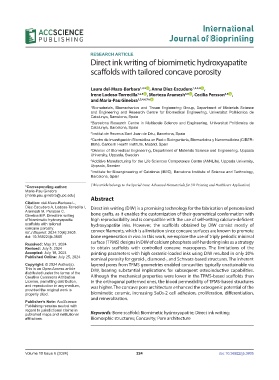Page 232 - IJB-10-6
P. 232
International
Journal of Bioprinting
RESEARCH ARTICLE
Direct ink writing of biomimetic hydroxyapatite
scaffolds with tailored concave porosity
Laura del-Mazo-Barbara 1,2,3 id , Anna Diez-Escudero 1,2,3,4 id ,
Irene Lodoso-Torrecilla 1,2,3 id , Morteza Aramesh 5,6 id , Cecilia Persson 5,6 id ,
and Maria-Pau Ginebra 1,2,4,6,7 id
*
1 Biomaterials, Biomechanics and Tissue Engineering Group, Department of Materials Science
and Engineering and Research Centre for Biomedical Engineering, Universitat Politècnica de
Catalunya, Barcelona, Spain
2 Barcelona Research Centre in Multiscale Science and Engineering, Universitat Politècnica de
Catalunya, Barcelona, Spain
3 Institut de Recerca Sant Joan de Déu, Barcelona, Spain
4 Centro de Investigación Biomédica en Red—Bioingeniería, Biomedicina y Nanomedicina (CIBER-
BBN), Carlos III Health Institute, Madrid, Spain
5 Division of Biomedical Engineering, Department of Materials Science and Engineering, Uppsala
University, Uppsala, Sweden
6 Additive Manufacturing for the Life Sciences Competence Centre (AM4Life), Uppsala University,
Uppsala, Sweden
7 Institute for Bioengineering of Catalonia (IBEC), Barcelona Institute of Science and Technology,
Barcelona, Spain
*Corresponding author: (This article belongs to the Special Issue: Advanced Biomaterials for 3D Printing and Healthcare Application)
Maria-Pau Ginebra
(maria.pau.ginebra@upc.edu)
Abstract
Citation: del-Mazo-Barbara L,
Diez-Escudero A, Lodoso-Torrecilla I, Direct ink writing (DIW) is a promising technology for the fabrication of personalized
Aramesh M, Persson C,
Ginebra MP. Direct ink writing bone grafts, as it enables the customization of their geometrical conformation with
of biomimetic hydroxyapatite high reproducibility and is compatible with the use of self-setting calcium-deficient
scaffolds with tailored hydroxyapatite inks. However, the scaffolds obtained by DIW consist mostly of
concave porosity.
Int J Bioprint. 2024;10(6):3805. convex filaments, which is a limitation since concave surfaces are known to promote
doi: 10.36922/ijb.3805 bone regeneration in vivo. In this work, we explore the use of triply periodic minimal
surface (TPMS) designs in DIW of calcium phosphate self-hardening inks as a strategy
Received: May 31, 2024
Revised: July 5, 2024 to obtain scaffolds with controlled concave macropores. The limitations of the
Accepted: July 19, 2024 printing parameters with high ceramic-loaded inks using DIW resulted in only 20%
Published Online: July 25, 2024 nominal porosity for gyroid-, diamond-, and Schwarz-based structures. The inherent
Copyright: © 2024 Author(s). layered pores from TPMS geometries enabled concavities typically unattainable via
This is an Open Access article DIW, bearing substantial implications for subsequent osteoinductive capabilities.
distributed under the terms of the
Creative Commons Attribution Although the mechanical properties were lower in the TPMS-based scaffolds than
License, permitting distribution, in the orthogonal patterned ones, the blood permeability of TPMS-based structures
and reproduction in any medium, was higher. The concave pore architecture enhanced the osteogenic potential of the
provided the original work is
properly cited. biomimetic ceramic, increasing SaOs-2 cell adhesion, proliferation, differentiation,
and mineralization.
Publisher’s Note: AccScience
Publishing remains neutral with
regard to jurisdictional claims in
published maps and institutional Keywords: Bone scaffold; Biomimetic hydroxyapatite; Direct ink writing;
affiliations. Biomorphic structures; Concavity; Pore architecture
Volume 10 Issue 6 (2024) 224 doi: 10.36922/ijb.3805

